Lusitania - Picture
More about World War 1
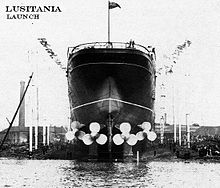
|
|
Lusitania
RMS Lusitania was a British ocean liner designed by Leonard Peskett and built by John Brown and Company of Clydebank, Scotland. The ship entered passenger service with the Cunard Line on 26 August 1907. The ship was named after the ancient Roman province of Lusitania, which is part of present day Portugal. During the First World War, as Germany waged submarine warfare against Britain, the ship was identified and torpedoed by the German U-boat U-20 on 7 May 1915 and sank in eighteen minutes. She went down eleven miles (19 km) off the Old Head of Kinsale, Ireland, killing 1,198 of the 1,959 people aboard, leaving 761 survivors. The sinking turned public opinion in many countries against Germany, contributed to the American entry into World War I and became an iconic symbol in military recruiting campaigns of why the war was being fought.
Lusitania was constructed as part of the competition between the Cunard Line and other shipping lines, principally from Germany, for the trans-Atlantic passenger trade. Whichever company had the fastest and most luxurious ships had a commercial advantage: Lusitania and her sister Mauretania together provided a regular express service between Britain and the United States until the intervention of the First World War. The two ships both held the Blue Riband speed record for a transatlantic crossing at different times in their careers. Mauretania was generally the slightly faster of the two and continued to hold the record after the war until 1929.
The ships were the first large liners to use Parsons' turbine propulsion, a technological leap which partly accounted for their 22-year retention of the speed record, while producing less onboard noise and vibration. The ships were the largest ever built at the time they were constructed, and had 50% greater passenger space than their nearest rivals, allowing unprecedented luxury for all three classes of passenger.
The Lusitania was designed so that she might readily be converted to an auxiliary cruiser in times of war as part of an agreement with the British government who provided a loan of Ł2.6 million to finance her and Mauretania's construction. The ships attracted an ongoing operating subsidy and also held a valuable mail contract. In the event, the ships proved too large to be practical armed cruisers (both because their size made them ready targets and because of their very high fuel consumption). Lusitania was released from the Royal Navy shortly after the commencement of the war with instructions to resume passenger services, while Mauretania performed service as a troop ship. Cunard expressed a desire to lay up the ship for the duration of the war, but under the terms of the subsidy contract they were required to make all their ships available for government use and to carry government cargoes.
Lusitania had the misfortune to fall victim to torpedo attack relatively early in the First World War, before tactics for evading submarines were properly implemented or understood. The contemporary investigations both in the UK and US into the precise causes of the ship's loss were obstructed by the needs of wartime secrecy and a propaganda campaign to ensure all blame fell upon Germany. Argument over whether the ship was a legitimate military target raged back and forth throughout the war as both sides made misleading claims about the ship. At the time she was sunk she was carrying a large quantity of rifle ammunition and other supplies necessary for a war economy, as well as civilian passengers. Several attempts have been made over the years since the sinking to dive to the wreck seeking information about precisely how the ship sank, and argument continues to the current day.
Development and construction

Picture - Lusitania was the first quadruple screw ocean liner.
Lusitania and her sister ship Mauretania were commissioned by Cunard as a response to increasing competition from rival trans-atlantic passenger companies. In particular the German Norddeutscher Lloyd (NDL) and Hamburg America Line (HAPAG) had larger, faster, modern, more luxurious ships than Cunard and were better placed, starting from German ports, to capture the lucrative trade in emigrants leaving continental Europe for America. In 1897 the NDL liner Kaiser Wilhelm der Grosse captured the Blue Riband from Cunard's Campania, before the prize was taken in 1900 by the HAPAG ship Deutschland, before being wrested back by NDL in 1903 with Kaiser Wilhelm II and Kronprinz Wilhelm. Cunard saw their business steadily declining.
The American millionaire businessman J. P. Morgan had decided to invest in trans-atlantic shipping by creating a new company International Mercantile Marine (IMM), and in 1901 had purchased the British freight shipper Frederick Leyland & Co and a controlling interest in the passenger White Star Line. In 1902 a 'Community of Interest' was agreed between IMM, NDL and HAPAG to fix prices and divide between them the trans-atlantic trade. The partners also acquired a 51% stake in the Dutch Holland America Line. Offers were made to purchase Cunard, which with French CGT were now their principle rivals. Cunard declined the offer, but lacked the financial resources to respond with new ships. The chairman of Cunard, Lord Inverclyde approached the British government for assistance. Faced with the impending collapse of the British liner fleet and consequent loss of national prestige, as well as the reserve of shipping for war purposes which it represented, they agreed to help. By an agreement signed in June 1903, Cunard was given a loan of Ł2.6 million to finance two ships, repayable over 20 years at a favourable interest rate of 2.75%. The ships would receive an annual operating subsidy of Ł75,000 each plus a mail contract worth Ł68,000. In return the ships would be built to admiralty specifications so that they could be used as auxiliary cruisers in wartime.
Design
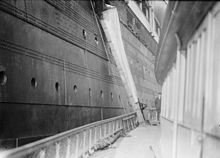
Picture - Lusitania unloading Christmas mail to a post office boat. The mail contract was a boost to the ship's regular income.
Cunard established a committee to decide the design for the new ships. James Bain, Cunard's Marine Superintendent was the chairman, while other members included Rear-Admiral H J Oram, who had been involved in designs for turbine powered ships for the navy, and Charles Parsons, whose company Parsons Marine was now producing revolutionary turbine engines. Parsons maintained that he could design engines capable of maintaining a speed of 25 knots, which would require 68,000 horse power. The largest turbine sets built thus far had been of 23,000 bhp for the Dreadnought class battleships, and 41,000 bhp for Invincible class battlecruisers, which meant the engines would be of a new untested design. Turbines offered the advantages of less vibration in operation, greater reliability at high speeds and better fuel consumption. It was agreed that a trial would be made by fitting turbines to Carmania which was already under construction. The result was a ship 1.5 knots faster than her conventionally powered sister Caronia with the expected improvements in passenger comfort and operating economy.
Lusitania was designed by Cunard's naval architect, Leonard Peskett. Peskett had built a large model of the proposed ship in 1902 showing a three-funnel design. A fourth funnel was implemented into the design in 1904 as it was necessary to vent the exhaust from additional boilers fitted after steam turbines had been settled on as the powerplant. The original plan called for three propellers, but this was altered to four because it was felt the necessary power could not be transmitted through just three. Four turbines would drive four separate propellers with additional reversing turbines connected to the two inner shafts only. To improve efficiency, the two propellers either side nearest the rudder rotated inwards, while the outer propellers rotated outwards. The outer turbines operated at high pressure, with the exhaust steam then passing to the inner low pressure turbines. The propellers were driven directly by the turbines since sufficiently robust gearboxes were not available until developed by Parsons in 1916. Instead turbines had to be designed to run much slower than their optimum efficient speeds. The efficiency of the installed turbines was less at slow speeds than a conventional triple expansion piston steam engine, but significantly better when the engines were run at high speed, as was usually the case for an express liner. There were 23 double ended boilers and two single ended (fitting the forward space where the ship narrowed), operating at a maximum 195 psi and containing 192 individual furnaces.
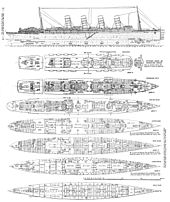
Picture - Deck plans of Lusitania. Changes were made both during construction and later. By 1915 the Lifeboat arrangement had been changed to 11 fixed boats either side plus collapsible boats stored under each lifeboat and on the after deck.
Work to refine the hull shape was conducted in the Admiralty experimental tank at Haslar, Portsmouth. As a result of experiments the beam of the ship was increased 10 feet compared to the initial design to improve stability. The hull immediately in front of the rudder and the balanced rudder itself followed naval design practice to improve rapid turning. The Admiralty contract required that all machinery be below the waterline, where it was considered to be better protected from gunfire. The rear third of the ship below water was used for the turbines, steering motors and four steam turbine driven 375Kw generators. The central half contained four boiler rooms, with the remaining space at the front of the ship reserved for cargo and other storage. Coal bunkers were placed along the length of the ship sandwiched between the hull and the boiler rooms, with a large transverse bunker immediately in front of the most forward, number 1 boiler room. Apart from convenience ready for use, the coal was considered to provide added protection for the central spaces against attack. At the very front were the chain lockers for the huge anchor chains and ballast tanks to adjust the ships trim. The hull space was divided into twelve watertight compartments, any two of which could be flooded without the ship sinking, connected by 35 hydraulically operated watertight doors. A critical difficulty with the watertight compartment design was that sliding doors to the coalbunkers needed to be open to feed coal all the time the ship was operating and closing these in emergency conditions could be problematic. The ship had a double bottom, with the space between divided into separate watertight cells. The ship's exceptional height was due to the six decks of passenger accommodation above the waterline, compared to the customary four decks in existing liners.
High-tensile steel was used for the ship's plating rather than the conventional mild steel. This allowed a reduction in plate thickness, reducing weight but still providing 26% greater strength than otherwise. Plates were held together by triple rows of rivets. The ship was heated and cooled throughout by a thermo-tank ventilation system, which used steam driven heat exchangers to warm air to a steady 65 °F (18.3 °C) while steam was injected into the airflow to maintain steady humidity. Forty-nine separate units driven by electric fans supplied seven complete air changes per hour throughout the ship in an interconnected system so that units could be switched out for maintenance. A separate system of exhaust fans removed air from galleys and bathrooms. As built, the ship conformed fully with Board of Trade safety regulations, which required sixteen lifeboats, with a capacity of approximately 1000 people.
Lusitania was the largest ship ever built at the time she was completed (though Mauretania, entering service shortly after, was slightly larger). She was 70 feet longer, two knots faster, and 10,000 tons larger than the most modern German liner, Kronprinzessin Cecilie. Passenger accommodation was 50% larger than any of her competitors providing for 552 saloon class, 460 cabin class and 1,186 in third class. Her crew comprised 69 on deck, 369 operating engines and boilers and 389 to attend to passengers. She had wireless telegraph, electric light, electrical lifts and sumptuous interiors.
Interiors
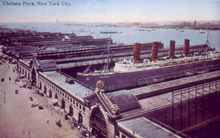
Picture - Postcard (about 1910) of Lusitania and Chelsea Piers
At the time of her launch Lusitania and her sister ship Mauretania possessed the most luxurious interiors afloat. The Scottish architect James Millar was chosen to design Lusitania's interiors, while Harold Peto was chosen to design Mauretania. Millar chose to use plasterwork to create interiors whereas Peto made extensive use of wooden panelling, with the result that the overall impression given by Lusitania was brighter than Mauretania. Lusitania's designs proved the more popular.
In common with all major liners of the period, Lusitania’s interiors were decorated with a mélange of historical styles. The first-class dining saloon was the grandest of the ship’s public rooms; arranged over two decks with an open circular well at its centre and crowned by an elaborate dome measuring 29 feet by 23 feet (8.8 m x— 7.0 m), decorated with frescos in the style of Franx§ois Boucher, it was elegantly realized throughout in the neoclassical Louis XVI style. The lower floor measuring 85 feet by 81 feet (26 m x— 25 m) could seat 323, with a further 147 on the 65 feet by 65 feet (20 m x— 20 m) upper floor. The walls were finished with white and gilt carved mahogany panels, with corinthian decorated columns where required to support the floor above. The one concession to seaborne life was that furniture was bolted to the floor, meaning passengers could not rearrange their seating for their personal convenience.
All other first-class public rooms were situated on the boat deck and comprised a lounge, reading and writing room, smoking room and veranda café. The last was an innovation on a Cunard liner and, in warm weather, one side of the café could be opened up to give the impression of sitting outdoors. However this would have been a rarely used feature given the often inclement weather of the north Atlantic. The first class lounge was decorated in Georgian style with inlaid mahogany panels surrounding a jade green carpet with a yellow floral pattern, measuring overall 68 feet by 65 feet (21 m x— 20 m). It had a barrel vaulted skylight rising to 20 feet (6.1 m) with stained glass windows each representing one month of the year. Each end of the lounge had a 14 feet (4.3 m) high green marble fireplace incorporating enamelled panels by Alexander Fisher. The design was linked overall with decorative plasterwork. The library walls were decorated with carved pillasters and mouldings marking out panels of grey and cream silk brocade. The carpet was rose, with Rose du Barry silk curtains and upholstery. The chairs and writing desks were mahogany, and the windows featured etched glass. The smoking room was Queen Anne style, with Italian walnut panelling and Italian red furnishings. The grand stairway linked all six decks of the passenger accommodation with wide hallways on each level and two lifts. First class cabins ranged from one shared room through various en-suite arrangements in a choice of decorative styles culminating in the two regal suites which each had two bedrooms, dining room, parlour and bathroom. The port suite decoration was modelled on the Petit Trianon.
The second-class public rooms were situated in a separate section of the superstructure aft of the first-class passenger quarters. Design work was deputised to Robert Whyte, who was the architect employed by John Brown. Although smaller and plainer, the design of the dining room reflected that of first class, with just one floor of diners under a ceiling with a smaller dome and balcony. Walls were panelled and carved with decorated pillars, all in white. As with first class, the dining room was situated lower down in the ship on the saloon deck. The smoking and ladies rooms occupied the accommodation space of the second class promenade deck, with the lounge on the boat deck. Cunard had not previously provided a separate lounge for second class; the 42 feet by 40 feet (13 m x— 12 m) room had mahogany tables, chairs and setees set on a rose carpet. The smoking room was 52 feet by 33 feet (16 m x— 10 m) with mahogany panelling, white plasterwork ceiling and dome. One wall had a mosaic of a river scene in Brittany, while the sliding windows were blue tinted. There were no second class cabin suites, only standard shared cabins.
Third-class accommodation was plainer still, but, in comparison to other ships of the period, surprisingly comfortable and spacious. The 79 feet by 60 feet (24 m x— 18 m) dining room was at the bow of the ship on the saloon deck, finished in polished pine as were the other third class public rooms. Meals were eaten at long tables and there were two sittings for meals. A piano was provided for passenger use. A ladies lounge and smoking room were provided on the shelter deck immediately above the dining room. The roofed and partially enclosed space between the two had seating and provided some third class sheltered deck access in bad weather. Cabins were shared with a mixture of 2, 4 or 6 bunks and a wash basin, which was a significant improvement on previously typical dormitories.
The Bromsgrove Guild had designed and constructed most of the trim on Lusitania. Waring and Gillow tendered for the contract to furnish the whole ship, but failing to obtain this still supplied a number of the furnishings.
Construction and trials
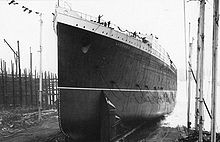
Picture - Lusitania's launch, 7 June 1906
Lusitania's keel was laid at John Brown on Clydebank as yard no. 367 on 16 June 1904, Lord Inverclyde hammering home the first rivet. Cunard nicknamed her 'the Scottish ship' in contrast to her sister whose contract went to Swan Hunter in England and who started building three months later. Final details of the two ships were left to designers at the two yards so that the ships differed in details of hull design and finished structure. The ships may most readily be distinguished in photographs through the flat topped ventilators used on Lusitania, whereas those on Mauretania used a more conventional rounded top. Mauretania was designed a little longer, wider, heavier and with an extra power stage fitted to the turbines.
The shipyard at John Brown had to be reorganised because of her size so that she could be launched diagonally across the widest available part of the river Clyde where it met a tributary, the ordinary width of the river being only 610 feet compared to the 786 foot long ship. The new slipway took up the space of two existing ones and was built on reinforcing piles driven deeply into the ground to ensure it could take the temporary concentrated weight of the whole ship as it slid into the water. Construction commenced at the bow working backwards, rather than the traditional approach of building both ends towards the middle. This was because designs for the stern and engine layout were not finalised when construction commenced. Railway tracks were laid alongside the ship and across deck plating to bring materials as required. The hull, completed to the level of the main deck but not fitted with equipment weighed approximately 16,000 tons.
The ship's stockless bower anchors weighed 10 1/4 tons, attached to 125 ton, 330 fathom chains all manufactured by N. Hingley and Sons, Ltd. The steam capstans to raise them were constructed by Napier brothers Ltd, of Glasgow. The turbines were 25 feet long with 12 ft diameter rotors, the large diameter necessary because of the relatively low speeds at which they operated. The rotors were constructed on site, while the casings and shafting was constructed in John Brown's Atlas works in Sheffield. The machinery to drive the 56 ton rudder was constructed by Brown Brothers of Edinburgh. A main steering engine drove the rudder through worm gear and clutch operating on a toothed quadrant rack, with a reserve engine operating separately on the rack via a chain drive for emergency use. The 17 ft three bladed propellers were fitted and then cased in wood to protect them during the launch.
The ship was launched on 7 June 1906, eight weeks later than planned because of strikes and eight months after Lord Inverclyde's death. Princess Louise was invited to name the ship but could not attend, so the honour fell to Inverclyde's widow Mary. The launch was attended by 600 invited guests and thousands of spectators. 1000 tons of drag chains were attached to the hull by temporary rings to slow it once it entered the water. The wooden supporting structure was held back by cables so that once the ship entered the water it would slip forward out of its support. Six tugs were on hand to capture the hull and move it to the fitting out berth.
Testing of the ship's engines took place in June 1907 prior to full trials scheduled for July. A preliminary cruise was arranged for 27 July with representatives of Cunard, the Admiralty, the Board of Trade, and John Brown aboard. The ship achieved speeds of 25.6 knots over a measured mile at Skelmorlie with turbines running at 194 revolutions per minute producing 76,000 shp. However, at high speeds the ship was found to suffer such vibration at the stern as to render the second class accommodation uninhabitable. VIP invited guests now came on board for a two day shakedown cruise during which the ship was tested under continuous running at speeds of 15, 18 and 21 knots but not her maximum speed. On 29 July the guests departed and three days of full trials commenced. The ship travelled four times between the Corsewall Light off Scotland to the Longship Light off Cornwall at 23 and 25 knots, between the Corsewall Light and Isle of Man, and Isle of Aran and Ailsa Craig. Over 300 miles an average speed of 25.4 knots was achieved, comfortably greater than the 24 knots required under the admiralty contract. The ship could stop in 4 minutes in 3/4 of a mile starting from 23 knots at 166 rpm and then applying full reverse. She achieved a speed of 26 Knots over a measured mile loaded to a draught of 33 feet, and managed 26.5 knots over a 60 mile course drawing 31.5 feet. At 180 revolutions a turning test was conducted and the ship performed a complete circle of diameter 1000 yards in 50 seconds. The rudder required 20 seconds to be turned hard to 35 degrees.
The vibration was determined to be caused by interference between the wake of the outer propellers and inner and became worse when turning. At high speeds the vibration frequency resonated with the ships stern making the matter worse. The solution was to add internal stiffening to the stern of the ship but this necessitated gutting the second class areas and then rebuilding them. This required the addition of a number of pillars and arches to the decorative scheme. The ship was finally delivered to Cunard on 26 August although the problem of vibration was never entirely solved and further remedial work went on through her life. In June 1908 the two outer propellers were replaced with others having a greater blade pitch which produced a modest improvement in performance. In April 1909 all four propellers were replaced with a four bladed design similar to those fitted on Mauretania with a six foot larger diameter weighing 23 tons. This change resulted in an approximate 1 knot increase in maximum speed and reduced vibration.
Comparison with the Olympic class
Lusitania and Mauretania were smaller than the White Star Line's Olympic-class vessels. Both vessels had been launched and had been in service for several years before the Olympic class ships were ready for the North Atlantic. Although significantly faster than the Olympic class would be, the speed of Cunard's vessels was not sufficient to allow the line to run a weekly transatlantic service from each side of the Atlantic. A third ship was needed for a weekly service, and in response to White Star's announced plan to build the three Olympic class ships, Cunard ordered a third ship: Aquitania. Like White Star Line's Olympic, Cunard's Aquitania had a slower service speed, but was a larger and more luxurious vessel.
The vessels of the Olympic class also differed from Cunard's Lusitania and Mauretania in the way in which they were compartmented below the waterline. The White Star vessels were divided by transverse watertight bulkheads. While Cunard's Lusitania also had transverse bulkheads, she additionally had longitudinal bulkheads running along the ship on each side, between the boiler and engine rooms and the coal bunkers on the outside of the vessel. The British commission that had investigated the Titanic disaster in 1912 heard testimony on the flooding of coal bunkers lying outside longitudinal bulkheads. Being of considerable length, when flooded, these could increase the ship's list and "make the lowering of the boats on the other side impracticable". - and this was precisely what later happened with Lusitania. Furthermore the ship's stability was insufficient for the bulkhead arrangement used: Flooding of only three coal bunkers on one side could result in negative metacentric height. On the other hand Titanic was given ample stability and sank with only a few degrees list, the design being such that there was very little risk of unequal flooding and possible capsize.
Career

Picture - Lusitania arriving New York on her maiden Voyage 7 Sep 1907
Lusitania, commanded by Commodore James Watt, moored at the Liverpool landing stage for her maiden voyage at 16:30 on Saturday 7 September 1907 as the onetime Blue Riband holder RMS Lucania vacated the pier. At the time Lusitania was the largest ocean liner in service and would continue to be until the introduction of Mauretania in November that year. During her eight-year service, she made a total of 202 crossings on the Cunard Line's Liverpool-New York Route.
A crowd of 200,000 people gathered to see her departure at 21:00 for Queenstown, where she was to take on more passengers. She anchored again at Roches Point, off Queenstown, at 09:20 the following morning, where she was shortly joined by Lucania, which she had passed in the night, and 120 passengers were brought out to the ship by tender bringing her total of passengers to 2,320. At 12:10 on Sunday Lusitania was again under way and passing the Daunt Rock Lightship. In the first 24 hours she achieved 561 miles, with further daily totals of 575, 570, 593 and 493 miles before arriving at Sandy Hook at 09:05 Friday 13 September, taking in total 5 days and 54 minutes, 30 minutes outside the record time held by Kaiser Wilhelm II of the North German Lloyd line. Fog had delayed the ship on two days, and her engines were not yet run in. In New York hundreds of thousands of people gathered on the bank of the River Hudson from Battery Park to pier 56. All New York's police had been called out to control the crowd. 100 horse drawn cabs had been queuing from the start of the day ready to take away passengers. During the week's stay the ship was made available for guided tours. At 15:00 on Saturday 21 September, the ship departed on the return journey, arriving Queenstown 04:00 27 September and Liverpool 12 hours later. The return journey was 5 days 4 hours and 19 minutes, again delayed by fog.
On her second voyage in better weather, Lusitania arrived at Sandy Hook on 11 October 1907 in the Blue Riband record time of 4 days, 19 hours and 53 minutes. She had to wait for the tide to enter harbour where news had proceeded her and she was met by a fleet of small craft, whistles blaring. Lusitania averaged 23.99 knots (44.43 km/h) westbound and 23.61 knots (43.73 km/h) eastbound. In December 1907, Mauretania entered service and took the record for the fastest eastbound crossing. Lusitania made her fastest westbound crossing in 1909 after her propellers were changed, averaging 25.85 knots (47.87 km/h). She briefly recovered the record in July of that year, but Mauretania recaptured the Blue Riband the same month, retaining it until 1929, when it was taken by SS Bremen.
Hudson Fulton Celebration
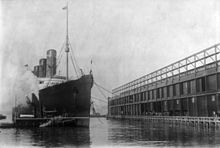
Picture - Photo of Lusitania arriving at Pier 54 in New York City in 1908
Lusitania and other ships participated in the Hudson-Fulton Celebration in New York City from the end of September to early October 1909. This was in celebration of the 300th anniversary of Henry Hudson's trip up the river that bears his name and the 100th anniversary of Robert Fulton's steamboat, Clermont. The celebration also was a display of the different modes of transportation then in existence, Lusitania representing the newest advancement in steamship technology. A newer mode of travel was the aeroplane. Wilbur Wright had brought a Flyer to Governors Island and proceeded to make demonstration flights before millions of New Yorkers who had never seen an aircraft. Some of Wright's trips were directly over Lusitania; several photographs of Lusitania from that week still exist.
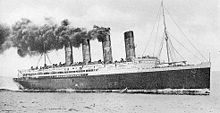
Picture - Lusitania with steam up on builder's trial
War
When Lusitania was built, her construction and operating expenses were subsidised by the British government, with the proviso that she could be converted to an Armed Merchant Cruiser if need be. At the outbreak of the First World War, the British Admiralty considered her for requisition as an armed merchant cruiser, and she was put on the official list of AMCs. The Admiralty then cancelled their earlier decision and decided not to use her as an AMC after all; large liners such as Lusitania consumed enormous quantities of coal (910 tons/day, or 37.6 tons/hour) and became a serious drain on the Admiralty's fuel reserves, so express liners were deemed inappropriate for the role when smaller cruisers would do. They were also very distinctive; so smaller liners were used as transports instead. Lusitania remained on the official AMC list and was listed as an auxiliary cruiser in the 1914 edition of Jane's All the World's Fighting Ships, along with Mauretania.
At the outbreak of hostilities, fears for the safety of Lusitania and other great liners ran high. During the ship’s first east-bound crossing after the war started, she was painted in a drab grey colour scheme in an attempt to mask her identity and make her more difficult to detect visually. When it turned out that the German Navy was kept in check by the Royal Navy, and their commerce threat almost entirely evaporated, it very soon seemed that the Atlantic was safe for ships like Lusitania, if the bookings justified the expense of keeping them in service.
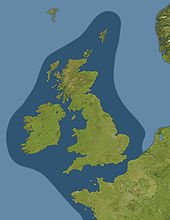
Picture - Germany's declared exclusion zone of February 1915. Ships within this area were liable to search and attack
Many of the large liners were laid up over the autumn and winter of 1914-1915, in part due to falling demand for passenger travel across the Atlantic, and in part to protect them from damage due to mines or other dangers. Among the most recognizable of these liners, some were eventually used as troop transports, while others became hospital ships. Lusitania remained in commercial service; although bookings aboard her were by no means strong during that autumn and winter, demand was strong enough to keep her in civilian service. Economizing measures were taken, however. One of these was the shutting down of her No. 4 boiler room to conserve coal and crew costs; this reduced her maximum speed from over 25 knots (46 km/h) to 21 knots (39 km/h). Even so, she was the fastest first-class passenger liner left in commercial service.
With apparent dangers evaporating, the ship’s disguised paint scheme was also dropped and she was returned to civilian colours. Her name was picked out in gilt, her funnels were repainted in their traditional Cunard livery, and her superstructure was painted white again. One alteration was the addition of a bronze/gold coloured band around the base of the superstructure just above the black paint.
1915
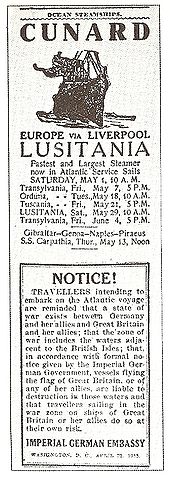
Picture - The official warning issued by the Imperial German Embassy about travelling on Lusitania.
By early 1915 a new threat began to materialize: submarines. At first they were used by the Germans only to attack naval vessels, and they achieved only occasional - but sometimes spectacular - successes. Then the U-boats began to attack merchant vessels at times, although almost always in accordance with the old cruiser rules. Desperate to gain an advantage on the Atlantic, the German government decided to step up their submarine campaign. On 4 February 1915 Germany declared the seas around the British Isles a war zone: from 18 February allied ships in the area would be sunk without warning. This was not wholly unrestricted submarine warfare since efforts would be taken to avoid sinking neutral ships.
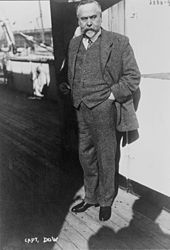
Picture - Captain Daniel Dow, Lusitania's penultimate captain
Lusitania was scheduled to arrive in Liverpool on 6 March 1915. The Admiralty issued her specific instructions on how to avoid submarines. Despite a severe shortage of destroyers, Admiral Henry Oliver ordered HMS Louis and Laverock to escort Lusitania, and took the further precaution of sending the Q ship Lyons to patrol Liverpool Bay. The destroyer commander attempted to discover the whereabouts of Lusitania by telephoning Cunard, who refused to give out any information and referred him to the admiralty. At sea the ships contacted Lusitania by radio, but did not have the codes used to communicate with merchant ships. Captain Dow of Lusitania refused to give his own position except in code, and since he was in any case some distance from the positions they gave, continued to Liverpool unescorted.
It seems that in response to this new submarine threat, some alterations were made to Lusitania and her operation. She was ordered not to fly any flags in the War Zone, a number of warnings and advices were sent to the ship’s commander in order to help him decide how to best protect his ship against the new threat, and it also seems that her funnels were most likely painted a dark grey to help make her less visible to enemy submarines. Clearly there was no hope of disguising her actual identity, since her profile was so well-known, and no attempt was made to paint out the ship’s name at the prow.
Captain Dow, apparently suffering from stress from operating his ship in the War Zone, and after a significant “false flag” controversy, left the ship; Cunard later explained that he was "tired and really ill." He was replaced with a new commander, Captain William Thomas Turner, who had previously commanded Lusitania, Mauretania and Aquitania in the years before the war.
On 17 April 1915 Lusitania left Liverpool on her 201st transatlantic voyage, arriving in New York on 24 April. A group of German-Americans, hoping to avoid controversy if Lusitania were attacked by a U-boat, discussed their concerns with a representative of the German embassy. The embassy decided to warn passengers before her next crossing not to sail aboard Lusitania. The Imperial German embassy placed a warning advertisement in 50 American newspapers, including those in New York (see illustration).
Last voyage and sinking
Departure
Lusitania departed Pier 54 in New York on 1 May 1915. The German Embassy in Washington had issued this warning on 22 April.
Notice! Travellers intending to embark on the Atlantic voyage are reminded that a state of war exists between Germany and her allies and Great Britain and her allies; that the zone of war includes the waters adjacent to the British Isles; that, in accordance with formal notice given by the Imperial German Government, vessels flying the flag of Great Britain, or any of her allies, are liable to destruction in those waters and that travellers sailing in the war zone on the ships of Great Britain or her allies do so at their own risk. Imperial German Embassy Washington, D.C. 22nd April 1915
Notice! Travellers intending to embark on the Atlantic voyage are reminded that a state of war exists between Germany and her allies and Great Britain and her allies; that the zone of war includes the waters adjacent to the British Isles; that, in accordance with formal notice given by the Imperial German Government, vessels flying the flag of Great Britain, or any of her allies, are liable to destruction in those waters and that travellers sailing in the war zone on the ships of Great Britain or her allies do so at their own risk. Imperial German Embassy Washington, D.C. 22nd April 1915
This warning was printed adjacent to an advertisement for Lusitania's return voyage. The warning led to some agitation in the press and worried the ship's passengers and crew.
Captain William Thomas Turner, known as "Bowler Bill" for his favourite shoreside headgear, had returned to his old command of Lusitania. He was commodore of the Cunard Line and a highly experienced master mariner, and had relieved Daniel Dow, the ship's regular captain. Dow had been instructed by his chairman, Alfred Booth, to take some leave, due to the stress of captaining the ship in U-boat infested sea lanes and for his protestations that the ship should not become an armed merchant cruiser, making her a prime target for German forces.. Captain Turner tried to calm the passengers by explaining that the ship's speed made her safe from attack by submarine. However, Cunard shut down one of the ship's four boiler rooms to reduce costs on sparsely subscribed wartime voyages, reducing her top speed from 25.5 to around 22 knots.
Lusitania steamed out of New York at noon on May 1, two hours behind schedule because of a last-minute transfer of forty-one passengers and crew from the recently requisitioned Cameronia. Shortly after departure three German-speaking men were found on board hiding in a steward's pantry. Detective Inspector William Pierpoint of the Liverpool police, who was travelling in the guise of a first class passenger, interrogated them before locking them in the cells for further questioning when the ship reached Liverpool. Also among the crew was an Englishman, Neal Leach, who had been working as a tutor in Germany before the war. Leach had been interned but later released by Germany. The German embassy in Washington was notified about Leach's arrival in America where he met known German agents. Leach and the three German stowaways went down with the ship, but they had probably been tasked with spying on the Lusitania and its cargo. Most probably, Pierpoint would already have been informed about Leach.

Picture - The Lusitania at the end of the first leg of her maiden voyage, New York City, September 1907. (The photo was taken with a panoramic camera.)
Passengers
Lusitania carried 1,959 people on her last voyage, with 1,265 passengers and 694 crew aboard. Those aboard included a large number of illustrious and renowned people including:
Theodate Pope Riddle, American architect and philanthropist (survived)
Canadian businessman Sir Frederick Orr Lewis, 1st Baronet (survived)
William R. G. Holt, son and heir of Canadian banker Sir Herbert Samuel Holt (survived)
Montreal socialite Frances McIntosh Stephens, wife of politician George Washington Stephens (died)
Mary Crowther Ryerson of Toronto, wife of George Sterling Ryerson, founder of the Canadian Red Cross (died)
Lindon W. Bates, Jr., New York engineer, economist and political figure (died)
British former MP David Alfred Thomas (survived)
His daughter Margaret, Lady Mackworth, British suffragist (survived)
Edwin W. Friend, professor of philosophy at Harvard University and co-founder of the American Society for Psychical Research (died, left a wife five months pregnant behind)
Oxford professor and writer Ian Holbourn (survived)
H. Montagu Allan's wife Marguerite (survived) and daughters Anna (died) and Gwendolyn (died)
Actresses Rita Jolivet (survived), Josephine Brandell (survived) and Amelia Herbert (died)
Belgian nurse Marie Depage (died), wife of surgeon Antoine Depage
New York fashion designer Carrie Kennedy (died) and her sister, Kathryn Hickson (died)
American building contractor and hotel proprietor Albert Bilicke (died)
Renowned chemist Anne Justice Shymer, president of the United States Chemical Company (died)
Playwright Charles Klein (died)
American writer Justus Miles Forman (died)
American theatre impresario Charles Frohman (died)
American philosopher, writer and Roycroft founder Elbert Hubbard (died)
His wife Alice Moore Hubbard, author and woman's rights activist (died)
Wine merchant and philanthropist George Kessler (survived)
American pianist Charles Knight (died) and sister, Elaine Knight (died)
Renowned Irish art collector and founder of the Hugh Lane Municipal Gallery in Dublin Sir Hugh Lane (died)
American socialite Beatrice Witherbee (survived), wife of Alfred S. Witherbee, president of the Mexican Petroleum Solid Fuel Company
Her son Alfred Scott Witherbee, Jr. (died) and her mother, Mary Cummings Brown (died)
American engineer and entrepreneur Frederick Stark Pearson (died) and his wife Mabel (died)
Genealogist Lothrop Withington (died)
Sportsman, millionaire, member of the Vanderbilt family, Alfred Gwynne Vanderbilt (died) - last seen fastening a life vest onto a woman holding a baby.
Scenic designer Oliver P. Bernard (survived), whose sketches of the sinking were published in the Illustrated London News
Politician and future United States Ambassador to Spain, Ogden H. Hammond of Louisville, Kentucky (survived) and his first wife, Mary Picton Stevens of Hoboken, New Jersey (died), a descendant of John Stevens and Robert Livingston Stevens (parents of former New Jersey Congresswoman Millicent Fenwick)
Dr. Howard L. Fisher, brother of Walter L. Fisher, former United States Secretary of the Interior (survived)
Herbert S. Stone, New York newspaper editor and publisher, creator of magazines The Chap Book and The House Beautiful, son of Melville Elijah Stone (died)
Rev. Dr. Basil W. Maturin, British theologist, author and rector of Saint Clement's Church in Philadelphia, Pennsylvania (died)
Debutant Miss Phyllis Hutchinson, 20-year-old niece of businessman Robert A. Franks of West Orange, New Jersey, financial agent for Andrew Carnegie (died)
Irish composer and conductor T. O'Brien Butler (died)
Arthur Henry Adams, president of the United States Rubber Company (died)
James A. Dunsmuir, of Toronto, Canadian soldier, younger son of James Dunsmuir (died)
Charles T. Jeffery, automobile manufacturer who became head of the Thomas B. Jeffery Company after his father's death (survived)
Paul Crompton, director of Booth Steamship Company Ltd. (died), and his wife Gladys (died), six children (died), and nanny (died)
Elisabeth Antill Lassetter, wife of Major General Harry B. Lassetter and sister of Major General John M. Antill (survived)
Josephine Eaton Burnside, daughter of Canadian department store founder Timothy Eaton (survived), and her daughter Iris Burnside (died)
Albert L. Hopkins, president of Newport News Shipbuilding and Drydock Company (died)
William Sterling Hodges, wife Sarah and two sons, William and Dean (all died)
William Broderick Cloete, mining entrepreneur who was returning to London from Mexico. His body was not found.
George Stevens, butcher of Princes Risborough, Buckinghamshire, England who had emigrated to the US a few years earlier but had decided to return to England (survived)
Submarine activity
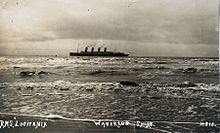
Picture - Lusitania entering the River Mersey, bound for Liverpool - her intended destination. Postcard photo taken from Waterloo, near Liverpool in 1908.
As the liner steamed across the ocean, the British Admiralty had been tracking the movements of U-20, commanded by Kapitx¤nleutnant Walther Schwieger, through wireless intercepts and radio direction finding. The submarine left Borkum on 30 April, heading north west across the North Sea. On 2 May she had reached Peterhead and proceeded around the north of Scotland and Ireland, and then along the western and southern coasts of Ireland, to enter the Irish Sea from the south. Although the submarine's departure, destination and expected arrival time were known to Room 40 in the admiralty, the activities of the decoding department were considered so secret that they were unknown even to the normal intelligence division which tracked enemy ships or to the trade division responsible for warning merchant vessels. Only the very highest officers in the admiralty saw the information and passed on warnings only when they felt it essential.
On 27 March, Room 40 had intercepted a message which clearly demonstrated that the Germans had broken the code used to pass messages to British merchant ships. Cruisers protecting merchant ships were warned not to use the code to give directions to shipping because it could just as easily attract enemy submarines as steer ships away from them. Queenstown was not given this warning and continued to give directions in the compromised code, which was not changed until after Lusitania's sinking. At this time the Navy was significantly involved with operations leading up to the landings at Gallipoli, and the intelligence department had been undertaking a program of misinformation to convince Germany to expect an attack on her northern coast. As part of this, ordinary cross-channel traffic to Holland was halted from 19 April and false reports were leaked about troop ship movements from British west and south coast ports. This led to a demand from the German army for offensive action against the expected troop movements, and consequently, a surge in German submarine activity on the British west coast. The fleet was warned to expect additional submarines, but this warning was not passed on to those sections of the navy dealing with merchant vessels. The return of the battleship Orion from Devonport to Scotland was delayed until 4 May and she was given orders to stay 100 miles from the Irish coast.
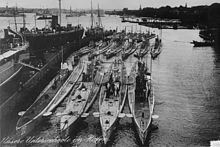
Picture - U-20 and sister ships in harbour at Kiel
On 5 May U-20 sank a merchant schooner, the Earl of Lathom, and fired a torpedo at Cayo Romano, a British steamer flying a neutral flag, both near Queenstown. The Royal Navy sent an uncoded warning to all ships at 10:30 pm on 5 May - "Submarines active off the south coast of Ireland" - and at midnight an addition was made to the regular nightly warnings, "submarine off Fastnet". On 6 May U-20 sank the 6,000 ton steamer Candidate. It then failed to get off a shot at the 16,000 ton liner Arabic, because although she keept a straight course the liner was too fast, but then sank another 6,000 ton British cargo ship flying no flag, Centurion, all in the region of the Coningbeg light ship. The specific mention of a submarine was dropped from the midnight broadcast on 6-7 May as news of the new sinkings had not yet reached the navy at Queenstown, and it was correctly assumed that there was no longer a submarine at Fastnet.
Captain Turner of Lusitania was given a warning message twice on the evening of 6 May, and took what he felt were prudent precautions. He closed watertight doors, posted double lookouts, ordered a black-out, and had the lifeboats swung out on their davits so that they could be launched quickly if necessary. That evening a Seamen's Charities fund concert took place throughout the ship and the captain was obliged to attend the event in the first class lounge.
At about 11:00 on 7 May, the Admiralty radioed another warning to all ships, probably as a result of a request by Alfred Booth who was concerned about Lusitania: "U-boats active in southern part of Irish Channel. Last heard of twenty miles south of Coningbeg Light Vessel". Booth and all of Liverpool had received news of the sinkings, which the admiralty had known about by at least 3:00 that morning. Turner adjusted his heading northeast, not knowing that this report related to events of the previous day and apparently thinking submarines would be more likely to keep to the open sea, so that Lusitania would be safer close to land. At 13:00 another message was received, "Submarine five miles south of Cape Clear proceeding west when sighted at 10:00am". This report was entirely inaccurate as no submarine had been at that location, but gave the impression that at least one submarine had been safely passed.
U-20 was low on fuel and only had three torpedoes left. On the morning of 7 May visibility was poor and Schwieger decided to head for home. He submerged at 11:00 after sighting a fishing boat which he believed might be a British patrol and shortly after was passed while still submerged by a ship at high speed. This was the cruiser Juno returning to Queenstown, travelling fast and zig-zagging having received warning of submarine activity off Queenstown at 07:45. The admiralty considered these old cruisers highly vulnerable to submarines and indeed Schwieger attempted to target the ship.
Sinking
On the morning of 6 May, Lusitania was 750 miles west of southern Ireland. By 5am on the 7 May she reached a point 120 miles west south west of Fastnet Rock (off the southern tip of Ireland), where she met the patrolling boarding vessel Partridge. By 6 am, heavy fog had arrived and extra lookouts were posted. As the ship came closer to Ireland Captain Turner ordered depth soundings to be made and at 8am for speed to be reduced to eighteen knots, then to 15 knots and for the foghorn to be sounded. Some of the passengers were disturbed that the ship appeared to be advertising her presence. By 10 am the fog began to lift, by noon it had been replaced by bright sunshine over a clear smooth sea and speed increased to 18 knots.
U-20 surfaced again at 12:45 as visibility was now excellent. At 13:20 something was sighted and Schwieger was summoned to the conning-tower: at first it appeared to be several ships because of the number of funnels and masts, but this resolved into one large steamer appearing over the horizon. At 13:25 the submarine submerged to periscope depth of 11 metres and set a course to intercept the liner at her maximum submerged speed of 9 knots. When the ships had closed to 2 miles Lusitania turned away, Schwieger feared he had lost his target, but she turned again, this time onto a near ideal course to bring her into position for an attack. At 700m range he ordered one gyroscopic torpedo to be fired, set to run at a depth of three metres, which was fired at 14:10.
In Schwieger's own words, recorded in the log of U-20:
Torpedo hits starboard side right behind the bridge. An unusually heavy detonation takes place with a very strong explosive cloud. The explosion of the torpedo must have been followed by a second one [boiler or coal or powder?]... The ship stops immediately and heels over to starboard very quickly, immersing simultaneously at the bow... the name Lusitania becomes visible in golden letters.
Leslie Morton, an eighteen-year-old lookout at the bow, spotted thin lines of foam racing toward the ship. He shouted "Torpedoes coming on the starboard side!" through a megaphone, thinking the bubbles came from two projectiles. The torpedo struck Lusitania under the bridge, sending a plume of debris, steel plating and water upward and knocking lifeboat number five off of its davits. "It sounded like a million-ton hammer hitting a steam boiler a hundred feet high," one passenger said. A second, more powerful explosion followed, sending a geyser of water, coal, dust, and debris high above the deck. Schwieger's log entries attest that he only launched one torpedo. Some doubt the validity of this claim, contending that the German government subsequently altered the published fair copy of Schwieger's log, but accounts from other U-20 crew members corroborate it. The entries were also consistent with intercepted radio reports sent to Germany by U-20 once she had returned to the North Sea, before any possibility of an official coverup.
German drawing of Lusitania being torpedoed. Incorrectly shows torpedo hit on port side of ship.
English drawing of Lusitania being torpedoed; incorrectly shows "second torpedo".
Lusitania is shown sinking as Irish fishermen race to the rescue. In fact, the launching of the lifeboats was more chaotic.
1915 painting depicting the sinking of Lusitania by the U-20.
At 14:12 Captain Turner ordered Quartermaster Johstone stationed at the ship's wheel to steer 'hard-a-starboard' towards the Irish coast, which Johnstone confirmed, but the ship could not be steadied on the course and rapidly ceased to respond to the wheel. Turner signalled for the engines to be reversed to halt the ship, but although the signal was received in the engine room, nothing could be done. Steam pressure had collapsed from 195 psi before the explosion, to 50 psi and falling afterwards. Lusitania's wireless operator sent out an immediate SOS, which was acknowledged by a coastal wireless station. Shortly afterward he transmitted the ship's position, 10 miles south of the Old Head of Kinsale. At 14:14 electrical power failed, plunging the cavernous interior of the ship into darkness. Radio signals continued on emergency batteries, but electric lifts failed, trapping passengers and crew; bulkhead doors closed as a precaution before the attack could not be reopened to release trapped men.
Captain Turner gave the order to abandon ship. Water had flooded the ship's starboard longitudinal compartments, causing a 15-degree list to starboard. The U-20's torpedo officer, Raimund Weisbach, viewed the destruction through the vessel's periscope and felt the explosion was unusually severe. Within six minutes, Lusitania's forecastle began to submerge.
Lusitania's severe starboard list complicated the launch of her lifeboats. Ten minutes after the torpedoing, when she had slowed enough to start putting boats in the water the lifeboats on the starboard side swung out too far to step aboard safely. While it was still possible to board the lifeboats on the port side, lowering them presented a different problem. As was typical for the period, the hull plates of Lusitania were riveted, and as the lifeboats were lowered they dragged on the inch high rivets, which threatened to seriously damage the boats before they landed in the water.
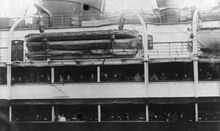
Picture - 1914 picture showing additional collapsible lifeboats added to the ship
Many lifeboats overturned while loading or lowering, spilling passengers into the sea; others were overturned by the ship's motion when they hit the water. It has been claimed that some boats, because of the negligence of some officers, crashed down onto the deck, crushing other passengers, and sliding down towards the bridge. This has been refuted in various articles and by passenger and crew testimony. Crewmen would lose their grip on the falls-ropes used to lower the lifeboats-while trying to lower the boats into the ocean, and this caused the passengers from the boat to "spill into the sea like rag dolls." Others would tip on launch as some panicking people jumped into the boat. Lusitania had 48 lifeboats, more than enough for all the crew and passengers, but only six were successfully lowered, all from the starboard side. A few of her collapsible lifeboats washed off her decks as she sank and provided refuge for many of those in the water.
There was panic and disorder on the decks. Schwieger had been observing this through U-20's periscope, and by 14:25, he dropped the periscope and headed out to sea. Later in the war, Schwieger was killed in action when, as commander of U-88, he was chased by HMS Stonecrop, hit a British mine, and sank on 5 September 1917, north of Terschelling. There were no survivors from U-88's sinking.
The track of Lusitania. View of casualties and survivors in the water and in lifeboats. Painting by William Lionel Wyllie.
The second explosion made passengers believe U-20 had torpedoed Lusitania a second time.
The effect of U-20's torpedo.
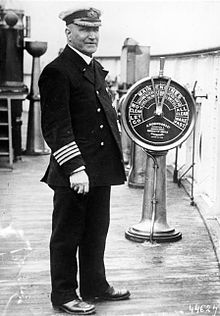
Picture - Captain Turner in 1915
Captain Turner remained on the bridge until the water rushed upward and destroyed the sliding door, washing him overboard into the sea. He took the ship's logbook and charts with him. He managed to escape the rapidly sinking Lusitania and find a chair floating in the water which he clung to. He survived, having been pulled unconscious from the water after spending three hours there. Lusitania's bow slammed into the bottom about 100 metres (330 ft) below at a shallow angle because of her forward momentum as she sank. Along the way, some boilers exploded, including one that caused the third funnel to collapse; the remaining funnels collapsed soon after. Turner's last navigational fix had been only two minutes before the torpedoing, and he was able to remember the ship's speed and bearing at the moment of the sinking. This was accurate enough to locate the wreck after the war. The ship travelled about two miles (3 km) from the time of the torpedoing to her final resting place, leaving a trail of debris and people behind. After her bow sank completely, Lusitania's stern rose out of the water, enough for her propellers to be seen, and went down.
Lusitania sank in 18 minutes, 11.5 miles (19 km) off the Old Head of Kinsale. 1,198 people died with her, including almost a hundred children. Afterwards, the Cunard line offered local fishermen and sea merchants a cash reward for the bodies floating all throughout the Irish Sea, some floating as far away as the Welsh coast. In all, only 289 bodies were recovered, 65 of which were never identified. The Cunard Steamship Company announced the official death toll of 1,195 on 1 March 1916. The bodies of many of the victims were buried at either Queenstown, where 148 bodies were interred in the Old Church Cemetery, or the Church of St. Multose in Kinsale, but the bodies of the remaining 885 victims were never recovered.
Two days before U-20 had sunk the Earl of Lathom but first allowed the crew to escape in boats. According to international maritime law any military vessel stopping an unarmed civilian ship was required to allow those on board time to escape before sinking it. The conventions had been drawn up in a time before the invention of the submarine and took no account of the severe risk a small vessel such as a submarine faced if it gave up the advantage of a surprise attack. Schwieger could have allowed the crew and passengers of Lusitania to take to the boats, but he considered the danger of being rammed or fired upon by deck guns too great. Merchant ships had, in fact, been advised to steer directly at any U-boat that surfaced. A cash bonus had been offered for any that were sunk, though the advice was carefully worded so as not to amount to an order to ram.
According to Bailey and Ryan, Lusitania was travelling without any flag and its name painted over with darkish dye.
One story states that when Lieutenant Schwieger of the U-20 gave the order to fire, his quartermaster, Charles Voegele, would not take part in an attack on women and children, and refused to pass on the order to the torpedo room - a decision for which he was court-martialed and served three years in prison at Kiel.
Official inquiries into the sinking
Immediately following the sinking, on 8 May, the local county coroner John Hogan opened an inquest in Kinsale into the deaths of two males and three females whose bodies had been brought ashore by a local boat, Heron. Most of the survivors (and dead) had been taken to Queenstown instead of Kinsale, which was closer. On 10 May Captain Turner gave evidence as to the events of the sinking where he described that the ship had been struck by one torpedo between the third and fourth funnels. This had been followed immediately by a second explosion. He acknowledged receiving general warnings about submarines, but had not been informed of the sinking of Earl of Lathom. He stated that he had received other instructions from the admiralty which he had carried out but was not permitted to discuss. The coroner brought in a verdict that the deceased had drowned following an attack on an unarmed non-combatant vessel contrary to international law. Half an hour after the inquest had concluded and its results given to the press, the Crown Solicitor for Cork, Harry Wynne, arrived with instructions to halt it. Captain Turner was not to give evidence and no statements should be made about any instructions given to shipping about avoiding submarines.
Board of Trade investigation
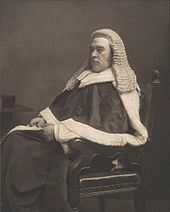
Picture - John Bigham, 1st Viscount Mersey, Commissioner of Wrecks
The formal Board of Trade investigation into the sinking was presided over by Wreck Commissioner Lord Mersey and took place in the Westminster Central Hall from 15-18 June 1915 with further sessions at the Westminster Palace Hotel on 1 July and Caxton Hall on 17 July. Lord Mersey had a background in commercial rather than maritime law but had presided over a number of important maritime investigations, including that into the loss of the Titanic. He was assisted by four assessors, Admiral Sir Frederick Samuel Inglefield, Lieutenant Commander Hearn and two merchant navy captains, D. Davies and J. Spedding. The Attorney General, Sir Edward Carson, represented the Board of Trade, assisted by the Solicitor General, F. E. Smith. Butler Aspinall, who had previously represented the Board of Trade at the Titanic inquiry, was retained to represent Cunard. A total of 36 witnesses were called, Lord Mersey querying why more of the survivors would not be giving evidence. Most of the sessions were public but two on 15 and 18 June were held in camera when evidence regarding navigation of the ship was presented.
Statements were collected from all the crew. These were all written out for presentation to the inquiry on standard forms in identical handwriting with similar phrasing. Quartermaster Johnston later described that pressure had been placed upon him to be loyal to the company, and that it had been suggested to him it would help the case if two torpedoes had struck the ship, rather than the one which he described. Giving evidence to the tribunal he was not asked about torpedoes. Other witnesses who claimed that only one torpedo had been involved were refused permission to testify. In contrast to his statement at the inquest, Captain Turner stated that two torpedoes had struck the ship, not one. In an interview in 1933, Turner reverted to his original statement that there had been only one torpedo. Most witnesses said there had been two, but a couple said three, possibly involving a second submarine. Clem Edwards, representing the seamen's union, attempted to introduce evidence about which watertight compartments had been involved but was prevented from doing so by Lord Mersey.
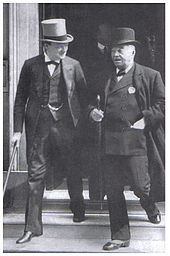
Picture - Churchill and Fisher
It was during the closed hearings that the Admiralty tried to lay the blame on Captain Turner, their intended line being that Turner had been negligent. The roots of this view began in the first reports about the sinking from Vice-Admiral Coke commanding the navy at Queenstown. He reported that "ship was especially warned that submarines were active on south coast and to keep mid-channel course avoiding headlands also position of submarine off Cape Clear at 10:00 was communicated by W/T to her..". Captain Webb, Director of the Trade Division, began to prepare a dossier of signals sent to Lusitania which Turner may have failed to observe. First Sea Lord Fisher noted on one document submitted by Webb for review,"As the Cunard company would not have employed an incompetent man its a certainty that Captain Turner is not a fool but a knave. I hope that Turner will be arrested immediately after the enquiry whatever the verdict". First Lord Winston Churchill noted, "I consider the admiralties case against Turner should be pressed by a skilful counsel and that Captain Webb should attend as a witness if not employed as an assessor. We will pursue the captain without check". In the event, both Churchill and Fisher were replaced in their positions before the enquiry because of the failures of the Gallipoli campaign.
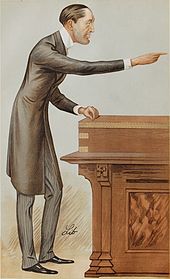
Picture - Edward Carson as depicted in Vanity Fair
Part of the proceedings turned on the question of proper evasive tactics against submarines. It was put to Captain Turner that he had failed to comply with admiralty instructions to travel at high speed, maintain a zig-zag course and keep away from shore. Naval instructions about zig-zag were read to the captain, who confirmed that he had received them, though later added that they did not appear to be as he recollected. This was unsurprising, since the regulations quoted had only been approved on 25 April, after Lusitania's last arrival in New York, and started distribution 13 May, after she sank. Lusitania had slowed to 15 knots at one point because of fog, but had otherwise maintained 18 knots passing Ireland. 18 knots was faster than all but nine other ships in the British merchant fleet could achieve and was comfortably faster than the submarine. Although he might have achieved 21 knots and had given orders to raise steam ready to do so, he was also under orders to time his arrival at Liverpool for high tide so that the ship would not have to wait to enter port. Thus he chose to travel more slowly. At the time, no ship had been torpedoed travelling at more than 15 knots. Although the admiralty instructed ships to keep well offshore and it was claimed that Turner had been only been 8 miles away, his actual distance when hit was thirteen miles. As a matter of established procedure, only ships travelling closer than five miles from shore were ordinarily being censured for being too close.
Turner stated that he had discussed the matter of what course the ship should take with his two most senior officers, Captain Anderson and Chief Officer Piper, neither of whom survived. The three had agreed that the admiralty warning 'submarine activity 20 miles south of Coningbeg', effectively overrode other admiralty advice to keep to 'mid channel', which was precisely where the submarine had been reported. He had therefore ordered the change of course at 12:40, intending to bring the ship closer to land and then take a course north of the reported submarine.
At one point in the proceedings Smith attempted to press a point he was making by quoting from a signal sent to British ships. Lord Mersey queried which message this was, and it transpired that the message in question existed in the version of evidence given to Smith by the Board of Trade Solicitor, Sir Ellis Cunliffe, but not in versions given to others. Cunliffe explained the discrepancy by saying that different versions of the papers had been prepared for use depending whether the enquiry had been in camera or not, but the message quoted appeared never to have existed. Lord Mersey observed that it was his job to get at the truth, and thereafter became more critical of admiralty evidence.
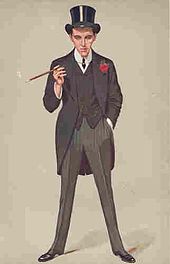
Picture - F. E Smith
On 10 June, just before the hearing, significant changes were made to the Defence of the Realm Act, which made it an offence to collect or publish information about the nature, use or carriage of 'war materials' for any reason. Previously this had only been an offence if the information was collected to aid the enemy. This was used to prohibit discussion about the ship's cargo. The rifle cartridges carried by the Lusitania were mentioned during the case, Lord Mersey stating that "the 5,000 cases of ammunition on board were 50 yards away from where the torpedo struck the ship".
An additional hearing took place on 1 July at the insistence of Joseph Marichal, who was threatening to sue Cunard for their poor handling of the disaster. He testified that the second explosion had sounded to him like the rattling of machine gun fire and appeared to be below the second class dining room at the rear of the ship where he had been seated. Information about Marechal's background was sought out by the British government and leaked to the press so as to discredit him.
Captain Turner, the Cunard Company, and the Royal Navy were absolved of any negligence, and all blame was placed on the German government. Lord Mersey found that Turner "exercised his judgment for the best" and that the blame for the disaster "must rest solely with those who plotted and with those who committed the crime".
Two days after he closed the inquiry, Lord Mersey waived his fees for the case and formally resigned. His last words on the subject were: "The Lusitania case was a damned, dirty business!" The full report has never been made available to the public. A copy was thought to exist amongst Lord Mersey's private papers after his death but has since proved untraceable.
American court proceedings
In the United States sixty-seven claims for compensation were lodged against Cunard which were all heard together in 1918. Judge Julius Mayer, who was chosen to hear the case, had previously presided over the case brought following the loss of the Titanic, where he had ruled in favour of the shipping company. Mayer was a conservative who was considered a safe pair of hands with matters of national interest, and whose favourite remark to lawyers was to "come to the point". The case was to be heard without a jury. The two sides agreed beforehand that no question would be raised regarding whether Lusitania had been armed or carrying troops or ammunition. Thirty-three witnesses who could not travel to the US gave statements in England to Commissioner R. V. Wynne. Evidence produced in open court for the Mersey investigation was considered, but evidence from the British closed sessions was not. The Defence of the Realm Act was invoked so that British witnesses could not give evidence on any subject it covered. Statements had been collected in Queenstown immediately after the sinking by the American Consul, Wesley Frost, but these were not produced.
Captain Turner gave evidence in England and now gave a more spirited defence of his actions. He argued that up until the time of the sinking he had no reason to think that zig-zagging in a fast ship would help. Indeed, that he had since commanded another ship which was sunk while zig-zagging. His position was supported by evidence from other Captains, who said that prior to the sinking of the Lusitania no merchant ships zig-zagged. Turner had argued that maintaining a steady course for 30 minutes was necessary to take a four point bearing and precisely confirm the ship's position, but on this point he received less support, with other captains arguing a two point bearing could have been taken in five minutes and would have been sufficiently accurate.
Many witnesses testified that portholes across the ship had been open at the time of the sinking, and an expert witness confirmed that such a porthole three feet under water would let in four tons of water per minute. Testimony varied on how many torpedoes there had been, and whether the strike occurred between the first and second funnel, or third and fourth. The nature of the official cargo was considered, but experts considered that under no conditions could the cargo have exploded. A record exists that Crewman Jack Roper wrote to Cunard in 1919 requesting expenses for his testimony in accord with the line indicated by Cunard.
Mayer's judgement was that "the cause of the sinking was the illegal act of the Imperial German Government", that two torpedoes had been involved, that the captain had acted properly and emergency procedures had been up to the standard then expected. He ruled that further claims for compensation should be addressed to the German government (which eventually paid $2.5 million in 1925).
International reaction
German reaction
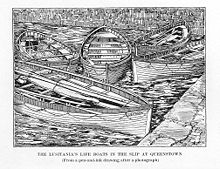
Picture - Illustration of Lusitania's life boats in the slip in Queenstown
On 8 May Dr. Bernhard Dernburg, the former German Colonial Secretary, made a statement in Cleveland, Ohio, in which he attempted to justify the sinking of Lusitania. At the time Dernburg was recognized as the official spokesman of the Imperial German government in the United States. Dernburg said that because Lusitania "carried contraband of war" and also because she "was classed as an auxiliary cruiser" Germany had had a right to destroy her regardless of any passengers aboard. Dernburg further said that the warnings given by the German Embassy before her sailing plus the 18 February note declaring the existence of "war zones" relieved Germany of any responsibility for the deaths of the American citizens aboard. He referred to the ammunition and military goods declared on Lusitania's manifest and said that "vessels of that kind" could be seized and destroyed under the Hague rules without any respect to a war zone.
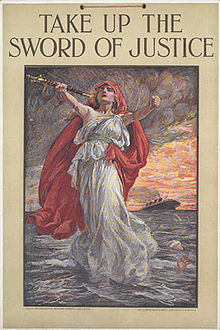
Picture - Take Up the Sword of Justice, a UK propaganda poster with Lusitania in the background
The following day the German government issued an official communication regarding the sinking in which it said that the Cunard liner Lusitania "was yesterday torpedoed by a German submarine and sank", that Lusitania "was naturally armed with guns, as were recently most of the English mercantile steamers" and that "as is well known here, she had large quantities of war material in her cargo".
Dudley Field Malone, Collector of the Port of New York, issued an official denial to the German charges, saying that Lusitania had been inspected before her departure and no guns were found, mounted or unmounted. Malone stated that no merchant ship would have been allowed to arm itself in the Port and leave the harbour. Assistant Manager of the Cunard Line, Herman Winter, denied the charge that she carried munitions:
She had aboard 4,200 cases of cartridges, but they were cartridges for small arms, packed in separate cases... they certainly do not come under the classification of ammunition. The United States authorities would not permit us to carry ammunition, classified as such by the military authorities, on a passenger liner. For years we have been sending small-arms cartridges abroad on the Lusitania. -New York Times, 10 May 1915
The fact that Lusitania had been carrying shells and cartridges was not made known to the British public at the time.
The sinking was severely criticized by and met with disapproval in Turkey and Austria-Hungary, while in the German press, the sinking was deplored by Vorwx¤rts, the daily newspaper of the Social Democratic Party of Germany, and also by Captain Persius, an outspoken naval critic who wrote for the Berliner Tageblatt.
In the aftermath of the sinking, the German government tried to justify it by claiming in an official statement that she had been armed with guns, and had "large quantities of war material" in her cargo. They also stated that since she was classed as an auxiliary cruiser, Germany had had a right to destroy her regardless of any passengers aboard, and that the warnings issued by the German Embassy before her sailing plus the 18 February note declaring the existence of "war zones", relieved Germany of any responsibility for the deaths of American citizens aboard. While it was true that Lusitania had been fitted with gun mounts as part of government loan requirements during her construction, to enable rapid conversion into an Armed Merchant Cruiser (AMC) in the event of war, the guns themselves were never fitted. However, she was still listed officially as an AMC. Her cargo had included an estimated 4,200,000 rounds of rifle cartridges, 1,250 empty shell cases, and 18 cases of non-explosive fuses, all of which were listed in her manifest, but the cartridges were not officially classed as ammunition by the Cunard Line. Various theories have been put forward over the years that she had also carried undeclared high explosives that were detonated by the torpedo and helped to sink her, but this has never been proven.
British and American actions
Schwieger was condemned in the Allied press as a war criminal.
Of the 139 US citizens aboard Lusitania, 128 lost their lives, and there was massive outrage in Britain and America, The Nation calling it "a deed for which a Hun would blush, a Turk be ashamed, and a Barbary pirate apologise" and the British felt that the Americans had to declare war on Germany. However, US President Woodrow Wilson refused to over-react. He said at Philadelphia on 10 May 1915:
There is such a thing as a man being too proud to fight. There is such a thing as a nation being so right that it does not need to convince others by force that it is right.
When Germany began its submarine campaign against Britain, Wilson had warned that the US would hold the German government strictly accountable for any violations of American rights.
During the weeks after the sinking, the issue was hotly debated within the administration. Secretary of State William Jennings Bryan urged compromise and restraint. The US, he believed, should try to persuade the British to abandon their interdiction of foodstuffs and limit their mine-laying operations at the same time as the Germans were persuaded to curtail their submarine campaign. He also suggested that the US government issue an explicit warning against US citizens travelling on any belligerent ships. Despite being sympathetic to Bryan's antiwar feelings, Wilson insisted that the German government must apologise for the sinking, compensate US victims, and promise to avoid any similar occurrence in the future.
Wilson notes
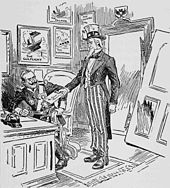
Picture - "A letter from the president of the United States". Contemporary US political cartoon
Backed by State Department second-in-command Robert Lansing, Wilson made his position clear in three notes to the German government issued on 13 May, 9 June, and 21 July.
The first note affirmed the right of Americans to travel as passengers on merchant ships and called for the Germans to abandon submarine warfare against commercial vessels, whatever flag they sailed under.
In the second note Wilson rejected the German arguments that the British blockade was illegal, and was a cruel and deadly attack on innocent civilians, and their charge that the Lusitania had been carrying munitions. William Jennings Bryan considered Wilson's second note too provocative and resigned in protest after failing to moderate it, to be replaced by Robert Lansing who later said in his memoirs that following the tragedy he always had the "conviction that we would ultimately become the ally of Britain".
The third note, of 21 July, issued an ultimatum, to the effect that the US would regard any subsequent sinkings as "deliberately unfriendly".
While the American public and leadership were not ready for war, the path to an eventual declaration of war had been set as a result of the sinking of the Lusitania. On 19 August U-24 sank the White Star liner SS Arabic, with the loss of 44 passengers and crew, three of whom were American. The German government, while insisting on the legitimacy of its campaign against Allied shipping, disavowed the sinking of the Arabic; it offered an indemnity and pledged to order submarine commanders to abandon unannounced attacks on merchant and passenger vessels.
The British public, press, and government in general were upset at Wilson's actions-not realizing it reflected general US opinion at the moment. They sneered "too proud or too scared". Shells that did not explode at the front were called "Wilsons".
German policy reversal
German Chancellor Theobald von Bethmann-Hollweg persuaded the Kaiser to forbid action against ships flying neutral flags and the U-boat war was postponed once again on 27 August, as it was realised that British ships could easily fly neutral flags.
There was disagreement over this move between the navy's admirals (headed by Alfred von Tirpitz) and Bethman-Hollweg. Backed by Army Chief of Staff Erich von Falkenhayn, Kaiser Wilhelm II endorsed the Chancellor's solution, and Tirpitz and the Admiralty backed down. The German restriction order of 9 September 1915 stated that attacks were only allowed on ships that were definitely British, while neutral ships were to be treated under the Prize Law rules, and no attacks on passenger liners were to be permitted at all. The war situation demanded that there could be no possibility of orders being misinterpreted, and on 18 September Henning von Holtzendorff, the new head of the German Admiralty, issued a secret order: all U-boats operating in the English Channel and off the west coast of the United Kingdom were recalled, and the U-boat war would continue only in the North sea, where it would be conducted under the Prize Law rules.
British propaganda
It was in the interests of the British to keep US passions inflamed, and a fabricated story was circulated that in some regions of Germany, schoolchildren were given a holiday to celebrate the sinking of the Lusitania. This story was so effective that James W. Gerard, the US ambassador to Germany, recounted it in his memoir of his time in Germany, Face to Face with Kaiserism (1918), though without substantiating its validity.
Goetz medal
In August 1915, Munich medalist and sculptor Karl X. Goetz (1875-1950), who had produced a series of propagandist and satirical medals as a running commentary on the war, privately struck a small run of medals as a limited-circulation satirical attack (fewer than 500 were struck) on the Cunard Line for trying to continue business as usual during wartime. Goetz blamed both the British government and the Cunard Line for allowing the Lusitania to sail despite the German embassy's warnings.
One side of the medal showed the Lusitania sinking laden with guns (incorrectly depicted sinking stern first) with the motto "KEINE BANNWARE!" ("NO CONTRABAND!"), while the reverse showed a skeleton selling Cunard tickets with the motto "Geschx¤ft xśber Alles" ("Business Above All").
Goetz had put an incorrect date for the sinking on the medal, an error he later blamed on a mistake in a newspaper story about the sinking: instead of 7 May, he had put "5. Mai", two days before the actual sinking. Not realizing his error, Goetz made copies of the medal and sold them in Munich and also to some numismatic dealers with whom he conducted business.
The British Foreign Office obtained a copy of the medal, photographed it, and sent copies to the United States where it was published in the New York Times on 5 May 1916. Many popular magazines ran photographs of the medal, and it was falsely claimed that it had been awarded to the crew of the U-boat.
British replica of Goetz medal
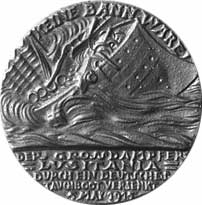
Picture - British replica of the Lusitania medal, with the date as "5 May"
The Goetz medal attracted so much attention that Lord Newton, who was in charge of Propaganda at the Foreign Office in 1916, decided to exploit the anti-German feelings aroused by it for propaganda purposes and asked department store entrepreneur Harry Gordon Selfridge to reproduce the medal. The replica medals were produced in an attractive case claiming to be an exact copy of the German medal, and were sold for a shilling apiece. On the cases it was stated that the medals had been distributed in Germany "to commemorate the sinking of the Lusitania" and they came with a propaganda leaflet which strongly denounced the Germans and used the medal's incorrect date to claim that the sinking of the Lusitania was premeditated. The head of the Lusitania Souvenir Medal Committee later estimated that 250,000 were sold, proceeds being given to the Red Cross and St. Dunstan's Blinded Soldiers and Sailors Hostel. Unlike the original Goetz medals which were sand-cast from bronze, the British copies were of diecast iron and were of poorer quality.
Belatedly realizing his mistake, Goetz issued a corrected medal with the date of "7. Mai". The Bavarian government suppressed the medal and ordered their confiscation in April 1917. The original German medals can easily be distinguished from the English copies because the date is in German, i.e. with a dot behind the number; the English version was altered to read 'May' rather than 'Mai'. After the war Goetz expressed his regret that his work had been the cause of increasing anti-German feelings, but it remains a celebrated propaganda act.
Last survivor
The last survivor was Audrey Lawson-Johnston (née Pearl), who was three months old when the RMS Lusitania was sunk. She died on 11 January 2011. She became the last living survivor following the deaths of Barbara McDermott (née Anderson) on 12 April 2008 and Ida Cantley on 31 December 2006.
Cultural influence
Charles Ives's Orchestral Set No. 2 concludes with a movement entitled, From Hanover Square North, at the End of a Tragic Day, the Voice of the People Again Arose. It recounts Ives's experience waiting for an elevated train in New York City as the news of the sinking of the Lusitania came through. The passengers assembled on the platform began singing "In The Sweet By and By" in time to a barrel organ which was playing the tune. Echoes of their voices can be heard at the start of the music, and the hymn tune itself appears at the end.
Controversies
Cruiser rules and exclusion zones
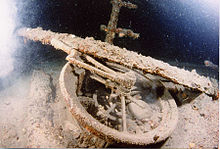
Picture - The telegraph on the wreck of Lusitania
The "Prize rules" or "Cruiser rules", laid down by the Hague Conventions of 1899 and 1907, governed the seizure of vessels at sea during wartime, although changes in technology such as radio and the submarine eventually made them redundant. Merchant ships were to be warned by warships, and their passengers and crew allowed to abandon ship before they were sunk, unless the ship resisted or tried to escape, or was in a convoy protected by warships. Limited armament on a merchant ship, such as one or two guns, did not necessarily affect the ship's immunity to attack without warning, and neither did a cargo of munitions or materiel.
In November 1914 the British announced that the entire North Sea was now a War Zone, and issued orders restricting the passage of neutral shipping into and through the North Sea to special channels where supervision would be possible (the other approaches having been mined). It was in response to this, and to the British Admiralty's order of 31 January 1915 that British merchant ships should fly neutral colours as a ruse de guerre, that Admiral Hugo von Pohl, commander of the German High Seas Fleet, published a warning in the Deutscher Reichsanzeiger (Imperial German Gazette) on 4 February 1915:
(1) The waters around Great Britain and Ireland, including the whole of the English Channel, are hereby declared to be a War Zone. From February 18 onwards every enemy merchant vessel encountered in this zone will be destroyed, nor will it always be possible to avert the danger thereby threatened to the crew and passengers. (2) Neutral vessels also will run a risk in the War Zone, because in view of the hazards of sea warfare and the British authorization of January 31 of the misuse of neutral flags, it may not always be possible to prevent attacks on enemy ships from harming neutral ships.
(2) Neutral vessels also will run a risk in the War Zone, because in view of the hazards of sea warfare and the British authorization of January 31 of the misuse of neutral flags, it may not always be possible to prevent attacks on enemy ships from harming neutral ships.
In response, the Admiralty issued orders on 10 February 1915 which directed merchant ships to escape from hostile U-boats when possible, but "if a submarine comes up suddenly close ahead of you with obvious hostile intention, steer straight for her at your utmost speed..." Further instructions ten days later advised armed steamers to open fire on a submarine even if it had not yet fired. Given the extreme vulnerability of a submarine to ramming or even small-caliber shellfire, a U-boat that surfaced and gave warning against a merchantman which had been given such instructions was putting itself in great danger. The Germans knew of these orders, even though they were intended to be secret, copies having been obtained from captured ships and from wireless intercepts; Bailey and Ryan in their "The Lusitania Disaster", put much emphasis on these Admiralty orders to merchantmen, arguing it was unreasonable to expect a submarine to surface and give warning under such circumstances. In their opinion this, rather than the munitions, the nonexistent armament, or any other suggested reason, is the best rationale for the Germans' actions in the sinking.
Contraband and second explosion
Included in Lusitania's cargo were 4,200,000 rounds of Remington 0.303 rifle cartridges, 1250 cases of empty 3-inch (76 mm) fragmentation shell casings, and eighteen cases of non-explosive fuses, all of which were listed on the ship's two-page manifest, filed with U.S. Customs after she departed New York on 1 May. However, these munitions were classed as small arms ammunition, were non-explosive in bulk, and were clearly marked as such. It was perfectly legal under American shipping regulations for the liner to carry these; experts agreed they were not to blame for the second explosion. Allegations the ship was carrying more controversial cargo, such as fine aluminium powder, concealed as cheese on her cargo manifests, or guncotton (pyroxylene) disguised as casks of beef, have never been proven. Recent expeditions to the wreck have shown that her cargo holds remain intact and show no evidence of internal explosion.
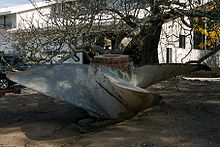
Picture - A propeller recovered from Lusitania
In 1993, Dr. Robert Ballard, the famous explorer who discovered Titanic and Bismarck, conducted an in-depth exploration of the wreck of Lusitania. Ballard found Light had been mistaken in his identification of a gaping hole in the ship's side. To explain the second explosion, Ballard advanced the theory of a coal-dust explosion. He believed dust in the bunkers would have been thrown into the air by the vibration from the explosion; the resulting cloud would have been ignited by a spark, causing the second explosion. In the years since he first advanced this theory, it has been argued that this is nearly impossible. Critics of the theory say coal dust would have been too damp to have been stirred into the air by the torpedo impact in explosive concentrations; additionally, the coal bunker where the torpedo struck would have been flooded almost immediately by seawater flowing through the damaged hull plates.
More recently, marine forensic investigators have become convinced an explosion in the ship's steam-generating plant is a far more plausible explanation for the second explosion. There were very few survivors from the forward two boiler rooms, but they did report the ship's boilers did not explode; they were also under extreme duress in those moments after the torpedo's impact, however. Leading Fireman Albert Martin later testified he thought the torpedo actually entered the boiler room and exploded between a group of boilers, which was a physical impossibility. It is also known the forward boiler room filled with steam, and steam pressure feeding the turbines dropped dramatically following the second explosion. These point toward a failure, of one sort or another, in the ship's steam-generating plant. It is possible the failure came, not directly from one of the boilers in boiler room no. 1, but rather in the high-pressure steam lines to the turbines. Most researchers and historians agree that a steam explosion is a far more likely cause than clandestine high explosives for the second explosion.
The original torpedo damage alone, striking the ship on the starboard coal bunker of boiler room no. 1, would probably have sunk the ship without a second explosion. This first blast was enough to cause, on its own, serious off-centre flooding, although the sinking would possibly have been slower. The deficiencies of the ship's original watertight bulkhead design exacerbated the situation, as did the many portholes which had been left open for ventilation.
Simon Lake's attempt to salvage in the 1930s
Between 1931 and 1935 an American syndicate comprising Simon Lake, one of the chief inventors of the modern submarine, and a US Navy officer, Captain H.H. Railey, negotiated a contract with the British Admiralty and other British authorities to partially salvage the Lusitania. The means of salvage was unique in that a 200 foot steel tube, five feet in diameter, which enclosed stairs, and a dive chamber at the bottom would be floated out over the Lusitania wreck and then sunk upright, with the dive chamber resting on the main deck of the Lusitania. Divers would then take the stairs down to the diver chamber and then go out of the chamber to the deck of the Lusitania. Lake's primary business goals were to salvage the purser's safe and any items of historical value. It was not to be though, and in Simon Lake's own words, "... but my hands were too full" -- i.e. Lake's company was having financial difficulties at the time-and the contract with British authorities expired 31 December 1935 without any salvage work being done, even though his unique salvage tunnel had been built and tested.
Recent developments
In 1967 the wreck of the Lusitania was sold by the Liverpool & London War Risks Insurance Association to former US Navy diver John Light for Ł1,000. Gregg Bemis became a co-owner of the wreck in 1968, and by 1982 had bought out his partners to become sole owner. He subsequently went to court in England in 1986, the US in 1995, and Ireland in 1996 to ensure that his ownership was legally in force.
None of the jurisdictions involved objected to his ownership of the vessel but in 1995 the Irish Government declared it a heritage site under the National Monuments Act, which prohibited him from in any way interfering with it or its contents. After a protracted legal wrangle, the Supreme Court in Dublin overturned the Arts and Heritage Ministry's previous refusal to issue Bemis with a five year exploration licence in 2007, ruling that the then minister for Arts and Heritage had misconstrued the law when he refused Bemis's 2001 application. Bemis planned to dive and recover and analyse whatever artefacts and evidence could help piece together the story of what happened to the ship. He said that any items found would be given to museums following analysis. Any fine art recovered, such as the paintings by Rubens, Rembrandt and Monet among other artists believed to have been in the possession of Sir Hugh Lane, who was believed to be carrying them in lead tubes, would remain in the ownership of the Irish Government.
In late July 2008 Gregg Bemis was granted an "imaging" licence by the Department of the Environment, which allowed him to photograph and film the entire wreck, and was to allow him to produce the first high-resolution pictures of it. Bemis planned to use the data gathered to assess the wreck's deterioration and to plan a strategy for a forensic examination of the ship, which he estimated would cost $5m. Florida-based Odyssey Marine Exploration (OME) were contracted by Bemis to conduct the survey. The Department of the Environment's Underwater Archaeology Unit was to join the survey team to ensure that research would be carried out in a non-invasive manner, and a film crew from the Discovery Channel was also to be on hand.
A dive team from Cork Sub Aqua Club, diving under license, discovered 15,000 rounds of the .303 (7.7x—56mmR) caliber rifle ammunition transported on the Lusitania in boxes in the bow section of the ship. The find was photographed but left in situ under the terms of the license. In December 2008, Gregg Bemis's dive team estimated a further four million rounds of .303 ammunition were on the ship at the time of its sinking. Mr. Bemis announced plans to commission further dives in 2009 for a full-scale forensic examination of the wreck.
The joint American-German production, The Sinking of the Lusitania: Terror at Sea premiered on the Discovery Channel on 13 May 2007, and on BBC One in the UK on 27 May 2007.
1950s damage from depth charges
Dublin-based technical diver Des Quiqley, who dived on the wreck in the 1990s with Bemis' permission, has reported that the wreck is "like Swiss cheese" and the seabed around her "is littered with unexploded hedgehog mines". Royal Navy officials have claimed they had merely been "practising" on the wreck, but others have suggested that in fact the Navy was deliberately trying to destroy evidence. Professor William Kingston of Trinity College, Dublin has said, "There's no doubt at all about it that the Royal Navy and the British government have taken very considerable steps over the years to try to prevent whatever can be found out about the Lusitania".
In February 2009, the Discovery Channel TV series Treasure Quest aired an episode titled "Lusitania Revealed", in which Gregg Bemis and a team of shipwreck experts explore the wreck via remote control unmanned submersible. At one point in the show it is mentioned that Cobh locals have believed for years that in the 1950s during a two week period, the Royal Navy dropped depth charges on the wreck, greatly worsening its condition. It was stated that numerous Cobh residents on shore heard the blasting and saw navy ships hovering over the area of the wreck. At one point in the show an unexploded depth charge was found in the wreckage, in plain sight, clearly seen by the remote control submersible's video camera. Gregg Bemis, as well as other people on the team, believe the British Royal Navy deliberately bombed the Lusitania site to "make the wreck as unattractive as possible, to prevent further salvage" and to "prevent divers from going in and finding that there was contraband cargo". No government has ever admitted to the depth charging. The narrator says the depth charges probably crushed the upper decks of the ship, and further scattered the debris field.
1984 British legal action
In 1982 various items were recovered from the wreck and brought ashore in the United Kingdom from the cargo of the Lusitania. Complex litigation ensued, with all parties settling their differences apart from the salvors and the British Government, who asserted "droits of admiralty" over the recovered items. The judge eventually ruled in The Lusitania [1986] QB 384 that the Crown has no rights over wrecks outside British territorial waters, even if the recovered items are subsequently brought into the United Kingdom. The case remains the leading authority on this point of law today.
Wreck site
The wreck of the Lusitania lies on its starboard side at an approximately 30 degree angle in 93 meters of sea water. The keel has an "unusual curvature" which may be related to a lack of strength from the loss of its superstructure. The beam is reduced with the funnels missing presumably to deterioration. The bow is the most prominent portion of the wreck with the stern damaged from depth charging in WWII as well as the removal of three of the four propellers by Oceaneering International in 1982.
List by death toll of ships sunk by submarines
Further reading
Bailey, Thomas A. "The Sinking of the Lusitania," The American Historical Review, Vol. 41, No. 1 (October 1935), pp. 54-73 in JSTOR
Bailey, Thomas A. "German Documents Relating to the 'Lusitania'", The Journal of Modern History, Vol. 8, No. 3 (Sep., 1936), pp. 320-37 in JSTOR
Bailey, Thomas A. and Paul B. Ryan. The Lusitania Disaster: An Episode in Modern Warfare and Diplomacy (1975)
Ballard, Robert D., & Dunmore, Spencer. (1995). Exploring the Lusitania. New York: Warner Books.
Doubleday, F.N. (January 1908). "A Trip On The Two Largest Ships]". The World's Work: A History of Our Time XV: 9803-9810. (available at Internet Archive)
Bernier, Michelle. "Did these Stories Really Happen?". (2010). Createspace
Beesly, Patrick (1982). Room 40: British Naval Intelligence, 1914-1918. Long Acre, London: Hamish Hamilton Ltd. ISBN 0-241-108640-0.
Hoehling, A.A. and Mary Hoehling. (1956). The Last Voyage of the Lusitania. Maryland: Madison Books.
Layton, J. Kent (2010). Lusitania: an illustrated biography. Amberley Books. ISBN 1848688342.
Layton, J. Kent (2011). The Edwardian Superliners: a trio of trios. Amberley publishing. ISBN 1848688350.
Ljungstrx¶m, Henrik. Lusitania. The Great Ocean Liners.
Molony, Senan (2004). Lusitania, an Irish Tragedy. Mercier. p. 192. ISBN 18566354520.
O'Sullivan, Patrick. (2000). The Lusitania: Unravelling the Mysteries. New York: Sheridan House.
Mitch Peeke; Kevin Walsh-Jones; Steven Jones (2002). The Lusitania story. Barnsley, Yorkshire: Leo Coope (Pen and Sword books). ISBN 0850529026.
Preston, Diana. (2002). Lusitania: An Epic Tragedy. Waterville: Thorndike Press. Preston (2002 p 384)
Preston, Diana (2002). Wilful Murder: The sinking of the Lusitania. London: Corgi (Transworld publishers). ISBN 0552 998869.
Ramsay (2001). Lusitania Saga and Myth. London: Chatham Publishing.
Sauder, Eric (2005). RMS Lusitania: The Ship and Her Record. London: The History Press. ISBN 978-0752452036.
Sauder, Eric (1992). RMS Lusitania: Triumph of the Edwardian Age. Redondo Beach CA: Trans-Atlantic Deigns. ISBN 978-0963394606.
Simpson, Colin. LIFE (1972 p 58). The Lusitania Sinking.
Simpson, Colin (1972). Lusitania. Book club associates.
The Sunday Times, (2008) "Is The Riddle of The Lusitania About to be Solved?"
Linda and Gary Cargill "Those Who Dream By Day"
Timeline, The Lusitania Resource.
Facts and Figures, The Lusitania Resource.
More aircraft.
Source: WikiPedia